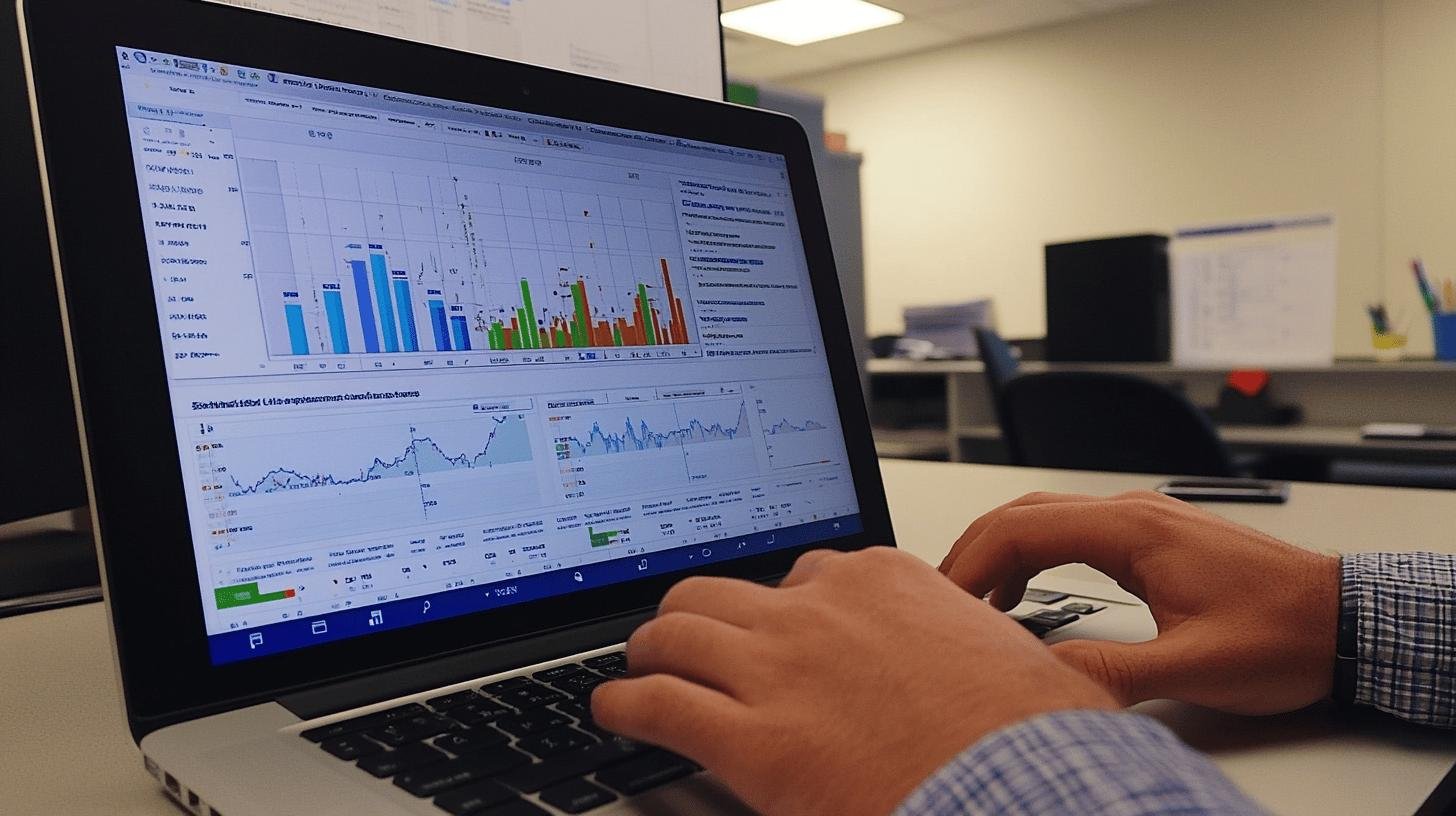This magical combo of analyzing data and making smart decisions is not just for big corporations—it’s the secret sauce for businesses of all sizes. From predicting market trends to boosting marketing campaigns, business analytics is transforming insights into actionable steps. Ready to dive in and see how this game-changer can power up your business? Let’s break it down into simple, bite-sized pieces.
Understanding the Application of Business Analytics
Business analytics involves analyzing data to obtain valuable insights that assist in decision-making and strategy creation. It delves into an organization’s data to understand current trends and predict future outcomes. Think of it as a map for navigating business challenges, revealing the best routes to success.
But why is business analytics essential? It helps companies understand their situations and make informed decisions. With businesses expected to generate over 94 zettabytes of data online in 2022, using analytics to sift through all that information becomes crucial. It identifies trends, highlights effective strategies, and aids in future planning.
Here are some key benefits of business analytics:
- Better Decision-Making: Enables data-driven choices.
- Cost Reduction: Pinpoints areas for saving money.
- Customer Insights: Understands customer behavior and preferences.
- Operational Efficiency: Streamlines business processes.
- Competitive Advantage: Stays ahead by using insights effectively.
Business Analytics in Finance

Business analytics is crucial in finance for predicting trends, spotting investment opportunities, and managing risks. Fund managers and corporate accountants use these tools for smarter decision-making.
1. Predicting Financial Trends
Financial analytics can forecast outcomes by examining past data. This helps companies prepare for market changes, whether a boom or a downturn. It’s like checking the weather before planning a picnic!
2. Identifying Investment Opportunities
Analytics can guide you to the next big investment. By analyzing data, it identifies profitable investments that might not be immediately obvious. Think of it as a treasure map pointing you to financial gems.
3. Risk Management
Business analytics helps spot potential risks before they become problems. By evaluating data, companies can develop strategies to mitigate these risks, acting as a safety net when things go wrong.
| Application | Benefit |
|---|---|
| Predicting Financial Trends | Better preparation for market changes |
| Identifying Investment Opportunities | Spotting profitable investments early |
| Risk Management | Reducing financial surprises |
Marketing and Business Analytics
Marketing analytics acts like a high-tech magnifying glass for your business, helping understand customer preferences and evaluate marketing strategies. Almost every marketing team uses it to make better decisions, improve user experience, and design products that people love.
Marketing analytics is vital because it enables data-driven decisions. Instead of guessing, you can know what customers want. It tracks what’s working and what isn’t, allowing you to adjust strategies on the go. This results in less wasted money and more successful campaigns. It’s like having a cheat code for marketing.
Here’s a look at some key applications of marketing analytics:
- Customer Segmentation: Divides customers into groups based on behavior and preferences.
- Campaign Performance Tracking: Monitors marketing efforts.
- Social Media Insights analyzes social platform data.
- Predictive Analytics: Forecasts future trends and customer behavior.
- A/B Testing: Compares different campaign versions to see which performs better.
Applications of Business Analytics in Supply Chain Management

Supply chain analytics optimizes logistics, inventory management, and supplier relationships. It helps businesses streamline processes, making everything run smoother and more efficiently.
Specific Applications in Supply Chain Management:
- Logistics Optimization: analyzes data to find efficient routes and methods for transporting goods, reducing costs and delivery times.
- Inventory Management: Tracks stock levels in real-time, preventing overstocking or stockouts.
- Supplier Relationship Management: evaluates supplier performance data to identify the best partners and negotiate better terms.
- Demand Forecasting: Uses predictive analytics to forecast customer demand and adjust inventory and production levels.
- Risk Management: Identifies potential supply chain risks to mitigate issues before they become significant problems.
| Metric | Tool | Application |
|---|---|---|
| Delivery Time | Route Optimization Software | Improving logistics efficiency |
| Stock Levels | Inventory Management Systems | Preventing overstocking and stockouts |
| Supplier Performance | Supplier Scorecards | Evaluating and selecting suppliers |
| Customer Demand | Predictive Analytics Tools | Forecasting demand |
| Risk Factors | Risk Management Platforms | Identifying and mitigating risks |
Human Resource Analytics
Human resource analytics (HR analytics) uses data to make better decisions about hiring, engaging, and retaining employees. By analyzing employee data, companies can create a happier, more productive workforce.
How HR Analytics is Used:
- Improving Hiring Processes: By analyzing past hiring data, companies can identify what makes a successful employee, speeding up the hiring process.
- Boosting Employee Engagement: Tracks engagement levels to see what motivates and makes employees happy.
- Aiding in Retention: analyzes why employees leave, helping companies retain their best talent.
Key Benefits of Using HR Analytics:
- Better Hiring Decisions: Finds top candidates quickly.
- Increased Employee Engagement: Keeps employees motivated and satisfied.
- Improved Retention Rates: Reduces turnover by understanding why employees leave.
- Enhanced Performance Management: Tracks and improves employee performance.
- Cost Savings: Reduces hiring and training costs.
Real-Time Business Analytics

Real-time business analytics analyzes live data to make instant decisions, critical in fast-paced environments. It’s essential in retail and e-commerce, where quick changes require immediate responses.
Why Real-Time Analytics is a Game-Changer:
It allows businesses to react immediately. Imagine a store manager adjusting prices based on current sales data or a website changing its layout based on user behavior in real-time. This agility helps businesses stay competitive and meet customer needs right away.
Common Application of Business Analytics in Real Time:
- Dynamic Pricing: Adjusts prices based on real-time demand and supply.
- Customer Experience: Adapts website layouts or offerings based on user interactions.
- Inventory Management: Monitors stock levels and replenishes items as sold.
- Fraud Detection: Spots and stops fraudulent activities instantly.
- Operational Efficiency: Identifies bottlenecks instantly to streamline processes.
Conclusion
We’ve covered how business analytics peeks into the future. From finance to marketing, it makes data meaningful. Remember, business analytics isn’t just about crunching numbers. It’s about using that info to make smarter moves.
Whether you’re in finance, marketing, or supply chain, these tools help optimize everything. And in HR, they even make hiring a breeze. So, explore the application of business analytics, and you’ll see your business thrive!
FAQ
What is the application of business analytics in real life?
Business analytics are used in various fields such as finance, marketing, supply chain management, and human resources. It helps in making data-driven decisions to improve strategies and processes.
How is business analytics applied in marketing?
In marketing, business analytics track campaign performance, understand customer preferences, optimize ad spends, improve user experience, and design better products.
How is business analytics used in daily life?
Business analytics in daily life can be seen in personalized recommendations on shopping sites, targeted ads on social media, and optimized route planning for deliveries.
What are the applications of business analytics in finance?
In finance, business analytics predict financial trends, identify investment opportunities, and manage risks effectively.
How is business analytics applied in human resource management?
Human resource analytics improve hiring processes, enhance employee engagement, and help with talent retention by analyzing employee data.




